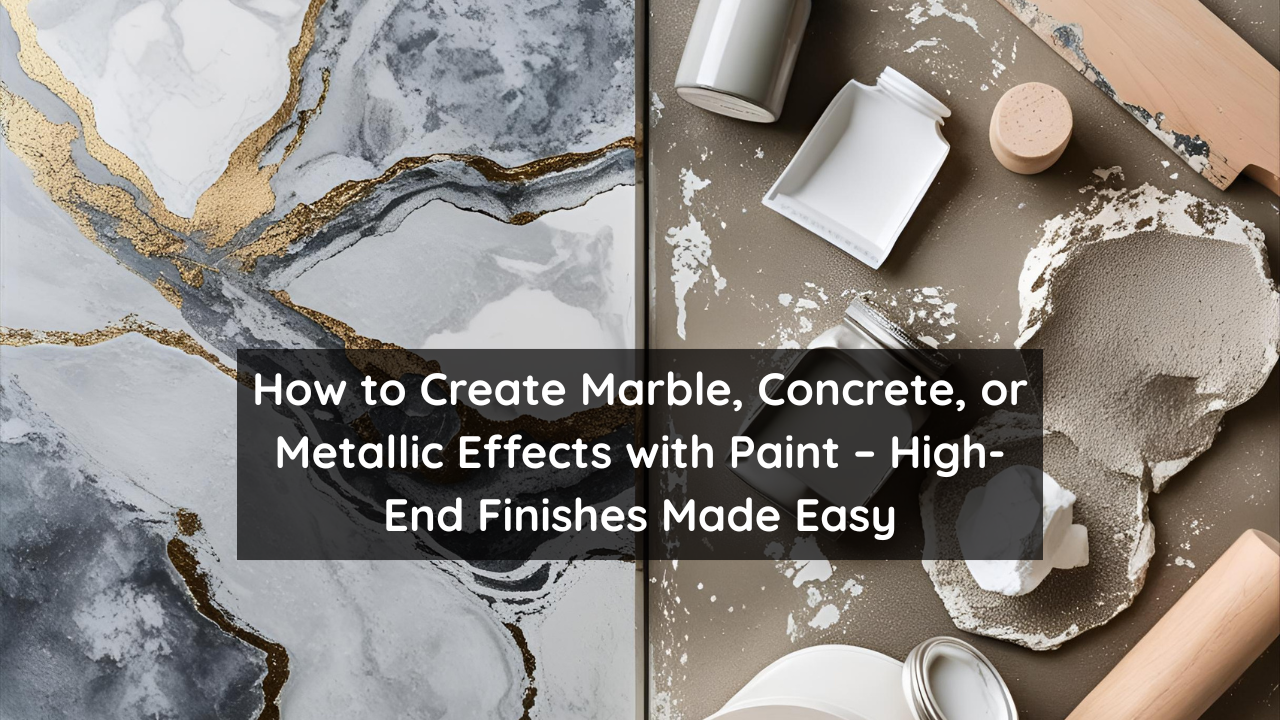If you love the luxurious look of marble, the raw edge of concrete, or the sleek shimmer of metallic finishes, you’ll be pleased to know you can achieve all these effects using just paint—no heavy materials required. These faux techniques can elevate any wall or surface, giving your space a high-end, designer look on a DIY-friendly budget.
In this guide, you’ll learn the step-by-step methods for recreating these sophisticated textures with paint, along with expert tips for getting realistic results.
Table of Contents
- Why Use Faux Finishes Instead of Real Materials
- Tools and Materials Needed
- How to Create a Marble Effect
- How to Create a Concrete Effect
- How to Create a Metallic Finish
- Tips for a Professional Look
- Final Thoughts
Why Use Faux Finishes Instead of Real Materials
Faux painting techniques are growing in popularity because they offer:
- A cost-effective alternative to real marble, concrete, or metal
- Lighter weight and easier installation (no tiles or slabs needed)
- Design flexibility, allowing you to customize size, color, and sheen
- Easier updates or removal, especially in rental properties
With the right tools and a little practice, you can mimic luxury materials and transform your walls, furniture, or even ceilings with depth and texture.
Tools and Materials Needed
Before you begin, gather these essentials:
| Item | Purpose |
|---|---|
| Latex or acrylic paints | For base and effect layers |
| Glaze or blending medium | Helps create depth and fluid transitions |
| Sea sponge or rags | For dabbing and texture |
| Feather or small brush | For fine veining (marble) |
| Putty knife or trowel | Useful for concrete texture layering |
| Metallic paint or powder | For shimmer and reflective finishes |
| Painter’s tape | To mask edges and protect trim |
| Drop cloth | Protects surrounding areas |
How to Create a Marble Effect
Step 1: Apply a Base Coat
Start with a neutral base color like white, light gray, or pale beige. Let it dry completely.
Step 2: Blend Secondary Colors
Use a sponge or soft rag to dab on a mix of gray, charcoal, or taupe in irregular patterns. Don’t aim for symmetry—marble is naturally uneven.
Step 3: Add Veins
Dip a feather or fine brush into a darker shade (charcoal, black, or deep gray) and lightly drag irregular lines across the wall to mimic veins. Blend gently using a damp sponge to soften harsh edges.
Step 4: Seal the Surface
Once dry, apply a clear glaze or satin finish for a polished stone look.
How to Create a Concrete Effect
Step 1: Use a Mid-Tone Gray Base
Start with a solid coat of gray paint. Choose a warm or cool gray depending on your room’s color scheme.
Step 2: Layer Texture
Mix a glaze with lighter and darker grays. Use a trowel, rag, or sponge to apply in random, overlapping patches. This builds visual texture and simulates the imperfections of real concrete.
Step 3: Blend and Fade
Work in small sections, blending as you go to avoid harsh lines. Add shadow effects with a slightly darker gray for depth.
Step 4: Optional Matte Finish
Seal with a matte or low-sheen topcoat to maintain the natural cement look.
How to Create a Metallic Finish
Step 1: Apply a Base Color
Use a base coat close to your metallic shade (black for silver or gold, deep blue for copper, etc.).
Step 2: Roll on Metallic Paint
Using a foam roller, apply the metallic paint in thin, even layers. Let each coat dry fully before applying the next to avoid streaks.
Step 3: Add Dimension
For more depth, sponge on a second metallic tone or glaze over selected areas. This gives the wall a more dynamic, light-reflective quality.
Step 4: Smooth or Textured Finish
Depending on your preference, you can leave the surface smooth or use a brush in crisscross patterns to create a brushed-metal effect.
Tips for a Professional Look
- Work in natural light to see color transitions clearly
- Practice on cardboard or a test board before applying to walls
- Use water-based glazes for easier cleanup and blending
- Don’t rush layering—let each coat dry fully before the next
- Use reference images of real materials for accuracy
You can find sample images and color references on design sites like Houzz or Benjamin Moore’s paint gallery.
Final Thoughts
Faux finishes like marble, concrete, and metallic paint effects allow you to add texture, elegance, and bold character to your walls—without the weight or cost of real materials. With the right supplies and a little patience, these techniques are achievable for DIYers of any experience level.
Whether you’re giving your living room a modern edge, upgrading your office space, or adding sophistication to a hallway, these finishes make a lasting impression.

